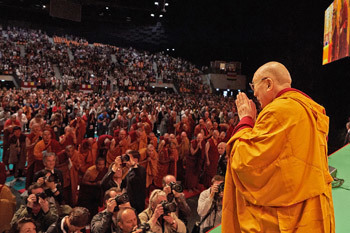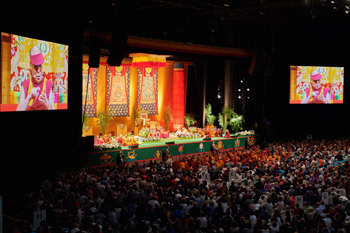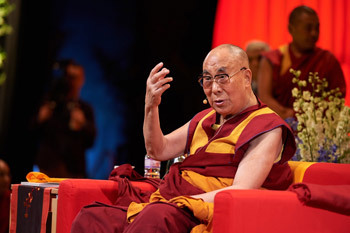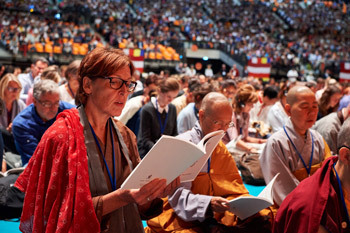Strasbourg, France, 17 September 2016 - Eight thousand eight hundred people gathered today in the Zénith de Strasbourg, an indoor sporting arena and concert hall designed in the Postmodern Expressionist style, to listen to His Holiness the Dalai Lama explain Nagarjuna’s ‘Commentary on Bodhichitta’. His Holiness spoke largely in Tibetan, which was eloquently translated into French by Ven Matthieu Ricard over the PA system. The teaching was also available through radios and headsets in English, Italian, German, Russian, Chinese, Portuguese, Spanish and Vietnamese. Live webcasts in these languages were available to the world at large.

|
His Holiness the Dalai Lama greeting the audience of 8,800 on his arrival on stage at the Zenith Arena in Strasbourg, France on September 17, 2016. Photo/Olivier Adam
|
On arrival at the hall, His Holiness walked directly from his car to the stage, where he greeted old friends among the monks gathered round the throne before coming to the edge of the stage to greet the audience. He took his seat and began without further ado.
“Dear Dharma friends, today we’re going to study a Buddhist text together. There are teachings that belong to the general structure of Buddhism and others tailored for specific individuals—these mostly comprise tantric teachings. This teaching belongs to the general structure. It is related to the Perfection of Wisdom Sutras, the most excellent teachings of the Buddha. Their implicit content has been clarified by Maitreya in works such as the ‘Ornament of Mahayana Sutras’, while their explicit content has been made clear by Nagarjuna in his ‘Fundamental Wisdom’, ‘70 Stanzas on Emptiness’ and ‘60 Stanzas on Reasoning’.
“In 8th century, the Tibetan Emperor, Trisong Detsen invited Shantarakshita and Padmasambhava to Tibet, and so Buddhism was established there. Shantarakshita was one of the pre-eminent scholars of Nalanda University at the time as his works ‘The Ornament of the Middle Way Teachings’ (Madhyamaka-alankara) and ‘Compendium of Reality’ (Tattvasamgraha) reveal. His student Kamalashila, who followed him to Tibet, composed a commentary to the ‘Compendium’.

|
A view of the stage at the Zenith Arena during His Holiness the Dalai Lama's teaching in Strasbourg, France on September 17, 2016. Photo/Olivier Adam
|
“The great adept Padmasambhava overcame obstacles to the establishment of Buddhism in Tibet and bestowed esoteric teachings on a close group of 25 disciples. Consequently, Tibet became the principle repository for the late flowering of Buddhism at Nalanda University. Tibetan Buddhism has sometimes been described as Lamaism as if it were not a mainstream tradition, but, just as the Nalanda tradition earlier reached China, Korea, Japan and Vietnam, all Tibetan Buddhist traditions trace their origins to Nalanda. The Sakyas look to the scholar Dharmapala who became the adept Virwapa. The Kagyus look to Naropa. Nyingmas look to Shantarakshita, while the original and renewed Kadampas also rely on the Nalanda tradition. Nalanda was the source of the streams of transmission that flowed through Tibet. Even Bön, Tibet’s indigenous religion, has today largely merged with the Buddhist tradition.”
His Holiness remarked that four of the thousand Buddhas of this fortunate aeon have so far appeared. He recalled that the Buddha was born into a noble family. Moved by signs of suffering in the world, he renounced his privileged life and for six years engaged in austerities. He finally sat beneath the Bodhi tree determined not to rise until he had attained enlightenment, which he did between the 3rd and 4th watch of the night.

|
His Holiness the Dalai Lama teaching at the Zenith Arena in Strasbourg, France on September 17, 2016. Photo/Olivier Adam
|
His Holiness mentioned that he prefers to refer to the Pali and Sanskrit traditions of the Buddha’s teachings. Both are grounded in the Vinaya traditions of monastic discipline. Tibetans follow the Mulasarvastivadin tradition according to which monks observe 253 precepts, while Buddhists of Burma, Thailand, Sri Lanka and so forth follow the Theravadin tradition, whose monks observe 227 precepts. To all intents and purposes the discipline they represent is the same.
Discussing what the Buddha taught, His Holiness explained that the Four Noble Truths dealing with suffering, its origin, its cessation and the path that are the foundation of his teaching. He mentioned that four characteristics can be understood in relation to each truth. The truth of suffering, for example, can be understood as being impermanent, in the nature of suffering, empty and selfless. When an understanding of the 16 characteristics of the Four Noble Truths is applied in practice it gives rise to the 37 factors aligned with enlightenment.
The Four Noble Truths comprise the first turning of the Wheel of Dharma. The second consists of the Perfection of Wisdom teachings of which there are extensive and abbreviated renditions. The Heart Sutra, which presents the Perfection of Wisdom in 25 lines, refers to the four-fold emptiness—“Form is empty; emptiness also is form. Emptiness is no other than form; form is no other that emptiness.” His Holiness remarked that emptiness is a property of form and so forth, and that emptiness and form are not found apart. In the same way, feeling, perception, formation and consciousness are empty of any essential existence, but exist by way of designation.

|
Members of the audience following the text during His Holiness the Dalai Lama's teaching in Strasbourg, France on September 17, 2016. Photo/Olivier Adam
|
The Heart Sutra was recited by the audience in French. His Holiness remarked:
“I have reflected on emptiness for 60 years. About 40 years ago I realised a coarse form of selflessness, which struck me like a bolt of lightning. As I have continued to reflect on that over the years I can see the effect it’s had on reducing my negative emotions. “
Turning to Nagarjuna’s ‘Commentary on Bodhichitta’, His Holiness observed that some scholars suggest that Nagarjuna was not its author because none of his students refer to it. However, they do not refer to others of his writings related to tantra either and this text is related to Guhyasamaja. He stated that he has received a reading transmission of it, but not an explanatory transmission. This makes its status similar to that of the ‘Perfection of Wisdom in Eight Thousand Lines’ in Central Tibet. He said that although the subject matter is Bodhichitta, it is not Bodhichitta in the sense just of an altruistic aspiration to enlightenment. Rather, it refers, as do the syllables E-vam, to the indivisibility of emptiness and bliss and the indivisibility of the two truths.
When His Holiness and the audience returned from lunch he began to read the text in earnest, selecting verses to highlight and explain.
4
6
Lacking attributes and origin
It does not ‘exist’, and words recoil from it.
The character of bodhichitta and enlightenment itself
Is indivisible from space.
48
And therefore bodhisattvas should at all time meditate
Upon this base of all phenomena:
Emptiness, the peaceful, illusion-like and groundless,
Which overthrows existence in samsara.
73
When yogis meditate
Upon this emptiness,
There is no doubt that there will rise in them
A longing for the benefit of others.
His Holiness commented that among the 7 billion human beings alive today, none of us wants to encounter suffering and yet we indulge in what gives rise to it. He noted the resonance with advice also found in Shantideva’s ‘Guide to the Bodhisattva’s Way of Life’:
76
Results, desired and undesired,
In good and evil states within this world,
All these derive from actions, good or ill,
That have been done to other beings.
In conclusion he quoted Vasabandhu as saying that the teachings consist of scripture and realization. In order for them to flourish, we need to study and practise.
Tomorrow, His Holiness will give the empowerment of Chenresig Jigten Wangchuk in the morning and a public talk in the afternoon.
















